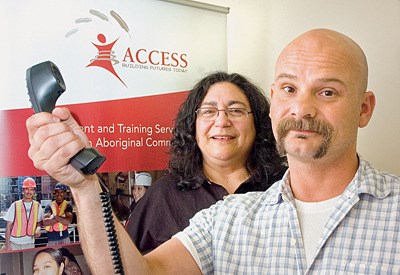The message board at the ACCESS aboriginal employment centre at Main and Hastings is a relic from a bygone era.
Little pink slips each folded in thirds to maintain some semblance of privacy are tacked to the wall awaiting their intended recipients. Even in this day of cellphone ubiquity, many low-income, homeless and otherwise marginalized people rely on this outdated paper system to get their messages.
Not having a phone number isnt just an inconvenience it makes it nearly impossible to connect with potential employers or landlords, keep in touch with family and friends or follow up on health-care needs.
Its a bad way to get the results of your HIV test, points out James Foster, a project manager at Luma Native Housing Society. Fortunately, hes offering an alternative.
For the past year and a half, Foster has been championing the Community Voice Mail Project, a program that offers free local telephone numbers and personalized voicemail accounts to low-income residents throughout the Lower Mainland. While the provincial government spends millions of dollars annually attempting to house, employ and otherwise serve the homeless population, Foster says something as simple and inexpensive as a local phone line is a crucial tool for enabling people to help themselves, though its often overlooked.
You can talk to somebody until youre blue in the face about how to go find a job, but if they cant have a phone number on their resumé its just not going to work, says Foster. The same thing goes for detox programs... same goes for housing.
The CVM program not only provides a consistent means of communication, adds Foster, it helps address the poverty stigma that arises when people have no option but to list a homeless shelter or social services agency as their primary contact number. Under CVM, each number has a local 778 prefix and each client records their own personal voicemail message so theres no indication of homelessness or poverty. Messages can be checked 24 hours a day from any phone. When people graduate from the system and obtain their own phones, numbers are reassigned.
Since introducing the system in Vancouver in February 2010, Foster says the response has been overwhelming.
An initial 500 numbers administered through 25 partner organizations went quickly. There are now 1,200 numbers assigned through 65 partner organizations throughout Vancouver, North Vancouver, Surrey and New Westminster. Of the people whove signed up, 80 per cent are homeless, 43 per cent are aboriginal and 49 per cent report being on income assistance. Foster says the number one stated goal of participants in the program is finding employment.
To date, 256 people have exited the program and of those 78 have found housing, 60 have received health care and 41 have landed jobs. Foster says CVM is also a good tool for people fleeing abusive relationships that need a phone line their partner cannot access.
Initial financial support for the program has come from the Vancouver Foundation and Coast Capital Savings while the technology was donated by CISCO. The City of Vancouver and the federal government have also signed on to contribute operating funds, but for the program to fly indefinitely, Foster says he needs the provincial government to come on board, something he believes makes fiscal sense. If we can invest millions upon millions of taxpayers dollars to help people get on their feet, something like this is a no-brainer.
The program costs about $180,000 annually to run. So far, Foster says his appeals for provincial funds have gone unanswered, even as provincially funded organizations like ACCESS are flocking to the program.
Paulette Seymour, executive director of Aboriginal Connections to Employment, which runs the ACCESS centre, says CVM has helped her clients get a handle on finding jobs and dealing with a host of other issues.
In the Downtown Eastside we cant deal with employment barriers in isolation of all the other social issues, she says, noting clients use CVM for everything from catching up with family and friends to making appointments to setting up court dates. But when it comes to finding a job, its absolutely crucial they can be reached by potential employers. A lot of the job search here is fast and furious, so its Craigslist and they phone... you have to be able to leave a number.
For job searcher Larry Johnny, a cellphone isnt in the budget and with a recent rent hike at his SRO, hes looking for a new place too. A CVM account is his best option for keeping in touch, he says. I check it four times a day and you can save as many messages as you want.
For more info on the CVM project visit LNHS.ca or follow @CVMVanBC on Twitter.



